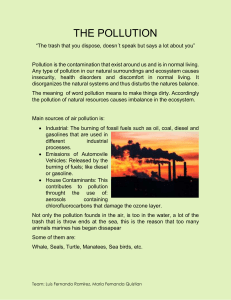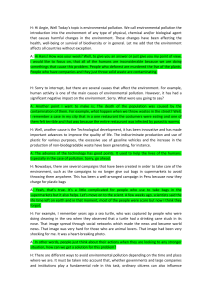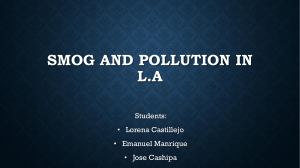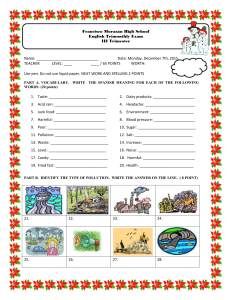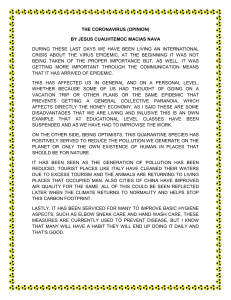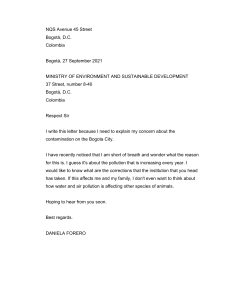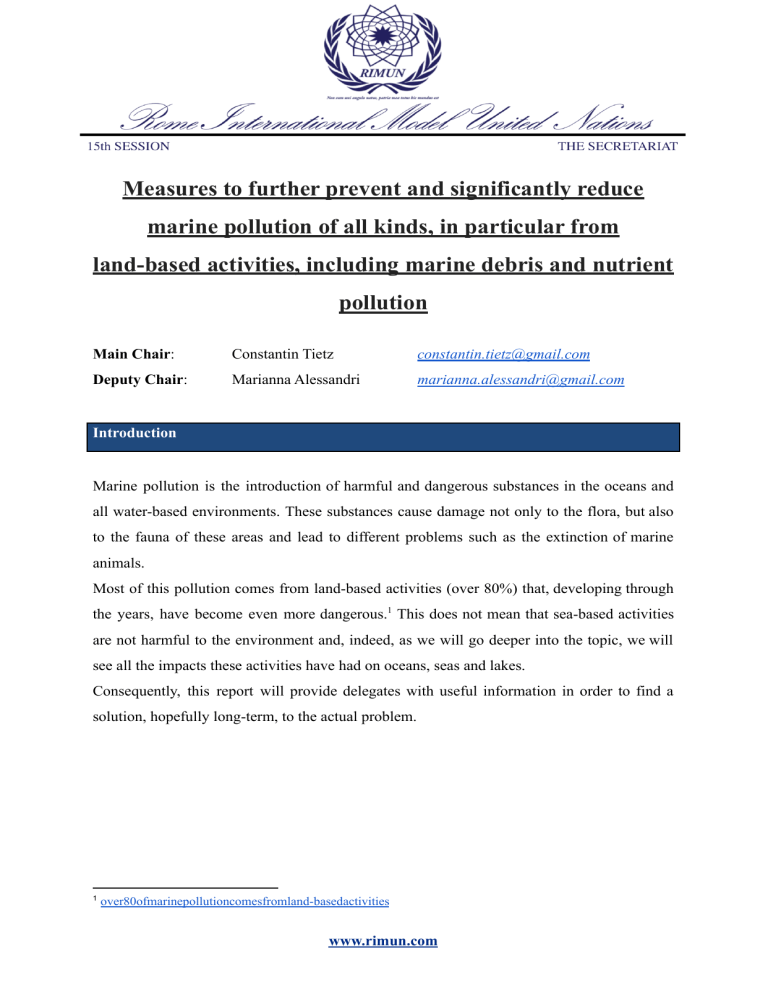
Measures to further prevent and significantly reduce marine pollution of all kinds, in particular from land-based activities, including marine debris and nutrient pollution Main Chair: Constantin Tietz [email protected] Deputy Chair: Marianna Alessandri [email protected] Introduction Marine pollution is the introduction of harmful and dangerous substances in the oceans and all water-based environments. These substances cause damage not only to the flora, but also to the fauna of these areas and lead to different problems such as the extinction of marine animals. Most of this pollution comes from land-based activities (over 80%) that, developing through the years, have become even more dangerous.1 This does not mean that sea-based activities are not harmful to the environment and, indeed, as we will go deeper into the topic, we will see all the impacts these activities have had on oceans, seas and lakes. Consequently, this report will provide delegates with useful information in order to find a solution, hopefully long-term, to the actual problem. 1 over80ofmarinepollutioncomesfromland-basedactivities www.rimun.com Land-based and sea-based activities As it has been mentioned before in this report, we will mainly analyse the effects land-based activities have had on water-based environments. However, we should not forget that also sea-based activities can be polluting. As regards land-based activities, they have had a major impact in regions dominated by the coast where the industry has found its roots to develop and evolve. Their main issue regards toxic substances released in water so that they could not affect human society. In spite of this, society is still indirectly affected by this release. As a matter of fact, toxic substances are nocive for marine animals as well as for human beings and killing or poisoning food is not useful for our society that now needs to find a solution to the decrease of such species. An alarming fact is that between 1970 and 2010 almost 74% of the entire population of the Scombridae fish family declined.2 Apart from this, land-based activities bring another kind of pollution which does not relate to any kind of material substance, instead it involves the sounds and noises machines produce when they work. Acoustic pollution is a problem usually underestimated, however it causes a great amount of damage to the environment. Guangzhou, a city in China, has been pointed out as the most noise-polluting city while Zurich the least, considering the percentage of hearing loss.3 2 3 https://www.abc.net.au/news/science/2015-09-16/half-marine-life-lost-in-40-years/6779912 these-are-the-cities-with-the-worst-noise-pollution www.rimun.com Sea-based activities, on the other hand, represent another threat to the well-being of the marine ecosystem. They mostly consist of extraction of species and seafloor exploitation, apart from the commercial and economic implications due to shipments. Despite this, the main problem still remains land-based activities, as said before. Different kinds of pollution The first aspect analysed is the activities that have led to marine pollution. Now we will proceed further and describe the kinds of pollution delegates shall discuss, focusing their attention on marine debris and nutrient pollution. www.rimun.com The marine ecosystem is put in danger by different activities that produce harmful substances such as nitrogen and phosphorus which are the main issue that characterises nutrient pollution. These substances are dissolved in water and act as a fertiliser, causing the so-called eutrophication phenomena. This phenomenon involves an incredible production of algae which leads to lower levels of oxygen in the water, less marine biodiversity and fish kills. For example, the Chesapeake Bay has faced an increase of suspended matter (e.g. silt, debris, mud) after heavy rainfall, as shown in the following picture. Now the runoff is located in urban areas as well as the bay. However, this is just an example of how the phenomenon works. Moreover, the primary elements that give birth to nutrient pollution come from land-based activities such as agriculture, stormwater and wastewater.4 Marine debris is another polluting phenomenon that needs to be addressed and stopped. It consists in solid waste disposal which does not work efficiently, causing the spread of toxic substances and materials such as plastic. The effects are quite known, they can be seen in plastic eaten by marine animals or the colour of water which changes due to the dissolved substances. The Mediterranean countries are the biggest concern regarding waste management since there are still many available and abandoned coastal dumpsites.5 The Strategic Action Plan (SAP-MED) is currently monitoring 4 5 sources-and-solutions https://www.medqsr.org/land-based-pollution-sources www.rimun.com this area and so far it has been possible to collect the following data regarding the MSW (Municipal Solid Waste) generation in Mediterranean countries.6 Another pollutant which is putting marine wildlife in danger is sediment. Sediments come from human activities near rivers that get rid of materials in water or urbanise the surroundings in order to implement their factories. Rivers’ water now is infected and polluted, this means that the flora 6 land-based-pollution-sources www.rimun.com and fauna of these areas will suffer and be put in danger. The Caribbean region produces 12% of global sediment input from rivers to oceans, resulting as one of the most affected areas.7 Oil hydrocarbons cause pollution too. They need to cross specific distribution routes which are not always safe. If the container of substances the such breaks, surroundings would be covered in oil hydrocarbons, resulting in pollution. In this case, it is again possible to point out the Caribbean area as one of the most affected territories.8 Last but not least, acoustic pollution must be addressed. It is mostly underestimated, however it is exceedingly harmful to a huge variety of marine animals such as whales. Acoustic pollution does not refer only to the noise of planes flying or ships moving, but it also consists of military and naval sonar systems which work like acoustic floodlights. Their sounds confuse whales, animals that base their survival on their sense of hearing, and this can lead to animal displacement, loss of preferred habitat and consequent extinction.9 Pollution comes from low and high-income countries and it does not entirely depend on the economic situation. It may happen that extremely small countries are among the greatest polluting countries.10 7 CEP_TR_33-en.pdf ibid 9 https://www.biologicaldiversity.org/campaigns/ocean_noise/index.html 10 marine-ocean-pollution-statistics-facts 8 www.rimun.com All the aforementioned pollutants are a threat to the environment. Many organisations know this and are actively sensitising society while carrying out research and projects in the field. Delegates may find different sites regarding initiatives currently taken up in “Useful Links and Bibliography”. Socio-economic implications The damages caused to the marine environment have been estimated to be $13 billion per year.11 This does not include all the costs involving clean-up activities, costs that low-income countries cannot bear, also taking into consideration awareness-raising campaigns.12 However, it is widely known that actors and companies are currently raising funds for this environmental problem. An example is a fund raised by Leonardo di Caprio for the Amazonian Forest alongside the G-7 initiative announced by French President Macron, when the forest was burned down.13 Even though so many actions have been taken throughout the years, it seems that only those who are negatively affected by pollution are taking it seriously, while big multinationals and the industrial world still do not fully recognise the negative outcome of all present actions.14 These actions are not enough to stabilise the phenomenon, so delegates shall propose initiatives to solve the issue, taking into consideration the costs and all socio-economic implications. Biodiversity situation The marine biodiversity and, generally speaking, the entire ecosystem has been put in danger since the industrialization process began in the 19th century. However, it is necessary to know to what extent the marine wildlife is actually under threat. The different kinds of pollution mentioned before have different impacts on the environment, but they all convey in making species disappear with the consequent habitat loss or malfunction. For 11 https://www.wti.org/institute/news/350/protecting-the-oceans-against-plastic-pollution/ Ibid 13 leonardo-dicaprio-pledges-5-million-to-reduce-amazon-rainforest-fires.html 14 https://www.wti.org/institute/news/350/protecting-the-oceans-against-plastic-pollution/ 12 www.rimun.com example, the poverty of reef fish is putting coral reefs in danger since there are not enough fish to block or slow the growth of algae.15 European bladderwrack forests are at risk too. In these environments the huge presence of filamentous algae is threatening the life of juvenile fish and many other organisms that cannot develop in such environments.16 Generally speaking, the marine ecosystem is endangered by human activities that produce pollutants. This process is described in the following picture. 15 16 biodiversity ibid www.rimun.com Overview TIMELINE 1954 Radioactive Waste 1972 Water Act 1975 London Convention 1980 Industrial Waste 1995 Fish Stocks Agreement 1996 Ocean dumping 1998 Sewage, Animal Waste, Sediments 2006 UN Environment Programme estimates that every square mile of the ocean contains 46,000 pieces of plastic17 and the London Protocol18 17 https://www.condorferries.co.uk/plastic-in-the-ocean-statistics#:~:text=There%20is%20now%205.25%20trillion,their% 20way%20into%20our%20oceans 18 https://www.epa.gov/ocean-dumping/ocean-dumping-management-timeline www.rimun.com 2010 Polar Program and Oil Spills 2014 Current Pollution 2020 100 million of marine animals die yearly from plastic waste19 GLOSSARY Nutrient pollution: process, also known as eutrophication, where too many nutrients, mainly nitrogen and phosphorus, are found in water acting as fertiliser, causing excessive growth of algae that leads to low levels of oxygen dissolved in water. Marine debris: marine debris is defined as any persistent solid material that is manufactured or processed and directly or indirectly, intentionally or unintentionally, disposed of or abandoned into the marine environment or the Great Lakes. Useful Links and Bibliography LBPS_SYN_Final_1.pdf CEP_TR_33-en.pdf https://www.unep.org/explore-topics/oceans-seas/what-we-do/working-regional-seas/land-based-pol lution still-one-earth-GPA.pdf land-based-pollution-sources https://www.sciencedirect.com/topics/earth-and-planetary-sciences/marine-pollution j.ctt46n21t.8.pdf 19 https://www.condorferries.co.uk/marine-ocean-pollution-statistics-facts#:~:text=100%20million%20marine%20animals %20die,by%20North%20Pacific%20fish%20yearly www.rimun.com https://www.sciencedirect.com/topics/earth-and-planetary-sciences/land-based-activity getprojectdoc.php 34parentattainsdescriptions.pdf https://www.abc.net.au/news/science/2015-09-16/half-marine-life-lost-in-40-years/6779912 index.html where-world-noisiest-city these-are-the-cities-with-the-worst-noise-pollution noise-pollution-is-still-widespread noise-pollution marine-litter-and-plastic-pollution land-and-sea-based-pollution ipen-ocean-pollutants-v2_1-en-web.pdf ocean-threats facts_about_nutrient_pollution_what_is_hypoxia.pdf the-decline-of-marine-biodiversity biodiversity-loss-oceans-can-be-reversed-through-habitat-restoration marine-biodiversity-dangerous-decline-finds-new-report facts-and-figures-on-marine-biodiversity critical-issues-marine-pollution www.rimun.com
